
Modern empires
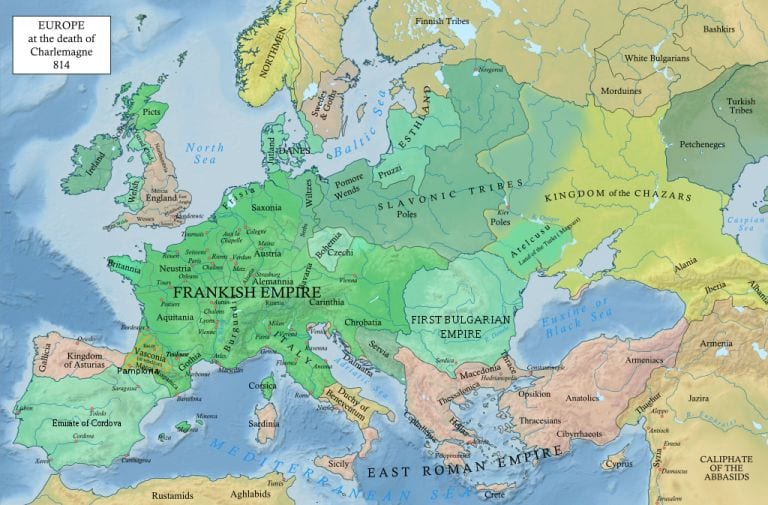
Europe at the time of Charlemagne’s death in 814 BCE
Courtesy Wikimedia Commons
Astrokey44 – Accessed 9 October 2017
Before reading this imperial perspective on human history a more general perspective is discussed in History in 10,000 words.
For an animated year-by-year overview of the history of urban empires see here.
For an animation of changes in political geography of Europe 1000-2013 see here.
For an animation 50 millennia in 10 minutes see here.
After the collapse of Rome Europe would languish until the Romanesque revival of Charlemagne in the 8th 9th centuries before the dawning of an era of modern empires, taken here to begin with an Islamic Golden Age that preceded the European Renaissance.
Introduction – modern empires
Following the Roman collapse, the Western European continent consisted of about 70 Germanic tribes divided into kingdoms of Goths, Vandals, Franks, and Saxons. They lived lives of subsistence in longhouses of about 12 people in extended families. A social hierarchy was headed by warrior chiefs elected by tribal councils. Conflict and looting of neighbouring clans was common. There was an oral tradition in law and custom.
religion was a nature-based spirit world with water bodies often treated as sacred sites, but also containing gods recognised in the names of the days of the week (Sun, Moon, Tiw, Wodin, Thor, Freya, Saturn). There was a love of the forest (wald) reflected in myths and legend. Food consisted mostly of porridge, barley Beer, and a little meat. The fibres were sheep’s wool, flax, and stinging nettle. There was a little written language as 26 runic symbols. Swords were cult objects. In 375 the Huns drove many clans to seek Roman protection.
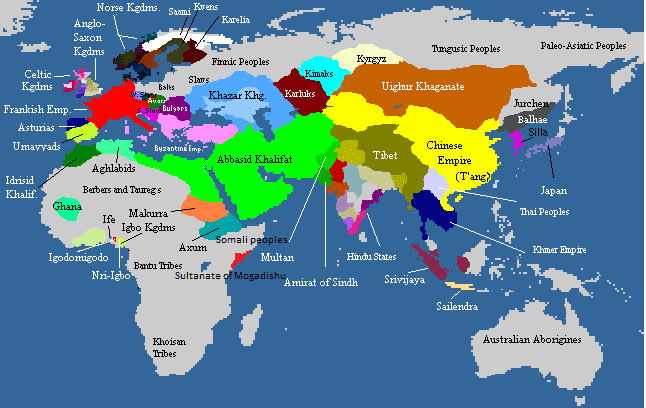
World in 820 CE
This was at the beginning of an Islamic Golden Age that lasted into the 13th century.
There are centres of civilization in the Near East and East Asia after the Axial Age (800-500 BCE) when Confucians, Daoists, Buddhists, Jainists, Zoroastrians, Jews, & Pre-Socratic philosophers questioned the nature of the physical and spiritual worlds, society, & human existence in a melting pot of ideas from which Christianity and Islam would emerge in the West
Courtesy Wikimedia Commons – Carlaude – Accessed 19 May 2017
On Christmas day of the year 800 Charlemagne (742–814) was crowned by Pope Leo III as king of the Franks and Emperor of a western Roman Catholic empire– the first emperor since Roman times. From his palace in Aachen (complete with a gynaecium as rooms for the womenfolk, a menagerie, gymnasium, and hunting park) the ‘Father of Europe’ emulated Roman traditions (Romanitas) by imposing a Carolingian Renaissance that reconstructed social order. This included: new taxes and tithes, bureaucratic administration, application of the law, an attack on pagan beliefs with a uniform liturgy and unification of territories under Catholicism, educational reform, revival of intellectual and cultural activities including the development of the miniscule Carolingian script that greatly simplified the production of manuscripts, and a royal library). Between 768 and 855 his building program produced 30 cathedrals and 417 monasteries round the Frankish empire. By conquering Italy and Gaul he united western Europe into a Frankish Carolingian Empire that combined today’s France, Germany, and Italy.
African Sahelian kingdoms
Africa south of the Sahara is often ignored. Around 750-1400 there were a series of kingdoms or empires controlling of trade across the sahel, the grasslands south of the Sahara and the desert. These Sahelian kingdoms included cities and dispersed populations farming livestock and using crafts that included metalwork, ceramics and textiles with independent currencies for trade along rivers and other waterways and across land using pack animals, mainly camels and horses. 750-1078 Ghana was dominant, after 1235 the Mali kingdom rose to prominence.
The Great Schism 1054-1453 – Western Latin Roman Catholic & Eastern Byzantine Greek Orthodox Churches of the remnant Roman Empire
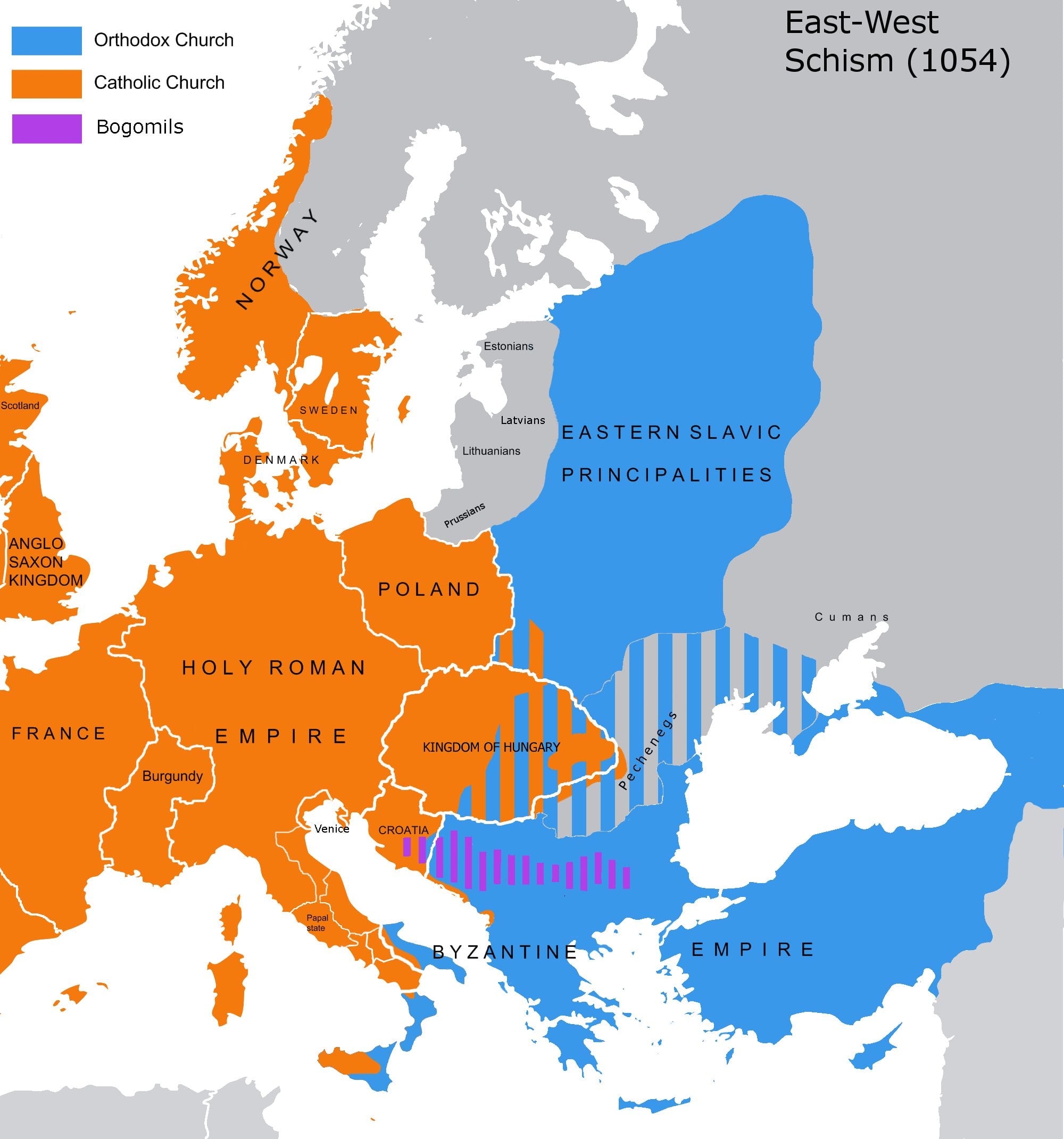
The Great Schism of 1054
Europe is divided by language, theology, and geography into Eastern Greek Orthodox and Western Roman Catholic Latin empires
Courtesy Wikimedia Commons
Astrokey44 – Accessed 9 October 2017
Rt click to enlarge
The schism arose from theological disputes between the Greek East and Latin West related to: the source of the Holy Spirit; the use of leavened or unleavened bread; the universal jurisdiction of the Bishop of Rome: and the position and role of Constantinople within the Western religious world.
In 1053 Greek churches in southern Italy were forced to either close or conform to Latin practices, the Ecumenical Byzantine Patriarch of Constantinople Michael Cerularius retaliating with the closure of all Latin churches in Constantinople. In 1054, a papal enissary of Leo IX travelled to Constantinople to deny Cerularius the title of ‘Ecumenical Patriarch’ and insist that he recognize the Pope’s claim to be universal head of th echurch, also to seek help from the Byzantine Emperor in relation to the Norman conquest of southern Italy. Cerularius refused the demand, excommunicated the leader of the legation, deepening the doctrinal, theological, linguistic, political, and geographical East-West division.
Reconciliation of the two factions was complicated by the Crusades, massacre of the Latins in 1182, the West’s retaliation in the Sacking of Thessalonica in 1185, the siege and capture Constantinople in 1204, and he of imposition of Latin patriarchs. The introduction of Latin hierarchies to Crusader states created two elaimants to the patriarchal sees of Antioch, Constantinople, and Jerusalem. In 1965, Pope Paul VI and the Ecumenical Patriarch of Constantinople Athenagoras I nullified the anathemas of 1054 as a goodwill gesture. Every year a delegation from each joins the celebrations of the other – Saints Peter and Paul (29 June) for Rome and Saint Andrew (30 November) for Constantinople.
Mongol Empire – 1206-1294

The expansion of the Mongol Empire – 1206-1294
Courtesy Wikimedia Commons
Astrokey44 – Accessed 9 October 2017
Rt click to enlarge
The Mongol Empire of the 13th to 14th centuries was a confederation of nomadic tribes united under Genghis Khan in 1206 which expanded from the steppes of Central Asia to become the largest continuous land empire in history stretching from the Levant to the Sea of Japan, north to Siberia and south into India, Indochina and the Iranian plateau with an enforced Pax Mongolica that facilitated freedom of trade, technologies and beliefs.
From the conflict between sons over succession the Toluids prevailed. Though the Mongols launched many more invasions on the Levant, briefly occupying it and raiding as far as Gaza before beginning withdrawal. By the time of Kublai’s death in 1294, the Mongol Empire had fractured into four separate khanates or empires before in 1304 the three western khanates briefly accepted the authority of the Yuan dynasty, then in 1368 the Han Chinese Ming dynasty occupied the Mongol capital, the Genghisid rulers of the Yuan returning to the Mongolian homeland to rule as the Northern Yuan dynasty before gradual dissolution of the remaining Khanates by 1335-1353.
The fortunes of the Silk Road were closely linked to those of the Mongol Empire. Mongol trade was the last wide-ranging land-based international trade as this horse-riding people traded along the Silk Road indulge the sense of wealth, power, and luxury, with goods like silk and cloth of gold, and developing trade centres like Samarkand. Remarkably they had no writing system.
Ottoman Empire 1289-1922/1923
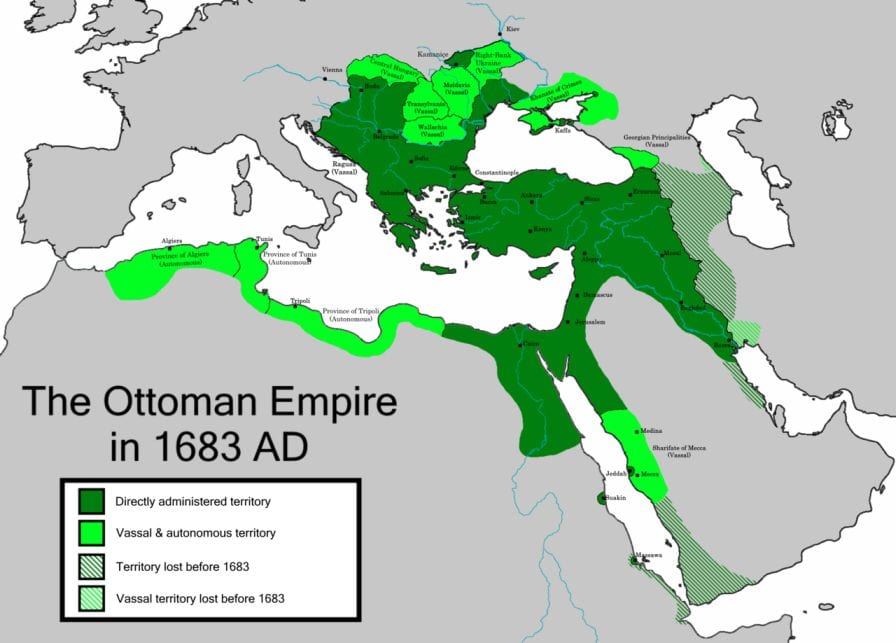
Ottoman Empire at its height in 1683
Courtesy Wikimedia Commons
Chamboz – Accessed 13 October 2017
Rt click to enlarge
The Ottoman or Turkish Empire was established at the end of the 13th century in NW Anatoliaat Sogut (today’s Bicelik Province) by the Oghuz leader Osman. In 1354 armies began a conquest of the Balkans creating a transcontinental empire and closing the last remnants of the Byzantine Empire with the conquest of Constantinople by Mehmed in 1453. During the 16th and 17th centuries, at its height under Suleiman the Magnificent, the empire was an open multinational, multilingual polity controlling much of SE Europe, parts of C Europe, W Asia the Caucasus, No th Africa, and the Horn of Africa and at the beginning of the 17th century consisted of 32 provinces and numerous vassal states.
With Constantinople as its capital the Ottoman Empire now controlled the Mediterranean basin and trade between East and West for six centuries but during the period 1740 to 1768 European military advances of the Habsburg and Russian Empires led to Ottoman defeats in the late 18th and early 19th centuries leading to modernization known as the Tanzimat although suffering further territorial losses, notably in the Balkans. In the early 20th century an alliance was formed with Germany. But there was internal dissent, especially with the Arab Revolt during which atrocities were committed against Armenians, Assyrians, and Pontic Greeks. Part of its territory was occupied by European powers after World War with the partitioning and loss of its Middle Eastern territory which was annexed by Britain and France. In a Turkish War of Independence resisting allied occupation there emerged the Republic of Turkey in the Anatolian heartland together with the abolition of the Ottoman monarchy.

Courtesy Wikimedia Commons
Accessed 8 October 2017

Courtesy Wikimedia Commons – Accessed 6 October 2018
British Empire – c. 1600-1914
The British Empire is made up of dominions, colonies, protectorates, mandates and other territories of the United Kingdom whose appropriation began as English coastal trading hubs established from the late 16th and extending to the early 18th century.
At its height in about 1900 it was the largest empire in history remaining a global power for more than 100 years such that in 1913 it comprised 412 M people which was 23% of the world population and by 1920 covered 24% of the world land surface. By the 18th century Britain and France had followed first Portugal and Spain in the 15th and 16th centuries in the Age of Discovery and
then the Netherlands in a phase of European colonial expansion. Following the union of England and Scotland in 1707 Great Britain became the leading colonial power in North America and following the East Indian Company’s conquest of Mughal Bengal at the Battle of Plassey in 1757 also the dominant power in the Indian subcontinent. The North American War of Independence in 1783 led
to the separation of thirteen American colonies.
Following the defeat of France in the Revolutionary and Napoleonic Wars (1792-1815) attention was directed to Asia, Africa and the Pacific using the world’s most accomplished 19th century to establish a Pax Britannica’ of 1815-1914. Britain led the world in an early 19th century Industrial Revolution culminating in the Great Exhibition of 1851 as Britain dominated world trade is part of the
acceleration of a global economy, as with a population explosion there was rapid urbanisation and an urgent need for raw materials leading to further imperial expansion into Egypt, South Africa, and elsewhere as Canada, Australia, and New Zealand became self-governing dominions.
By the early 20th century, Germany and the United States had industrialized, challenging Britain’s economic hegemony the following world war taxing resources and though the empire covered mor land than ever after the war the empire was now in decline which was accelerated by World War Il and a process of decolonization and independence to colonial territories was set in train many joining the British Commonwealth which currently contains 16 nations. Hong Kong was transferred to China in 1997 taken as the final end of the British Empire.
Indian Empire
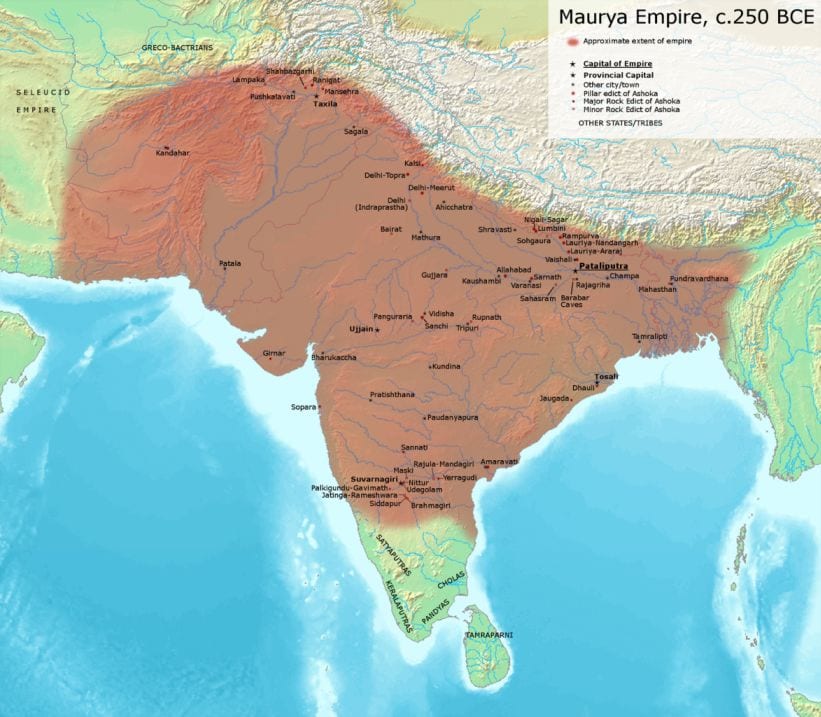
Indian empire
Portuguese Empire
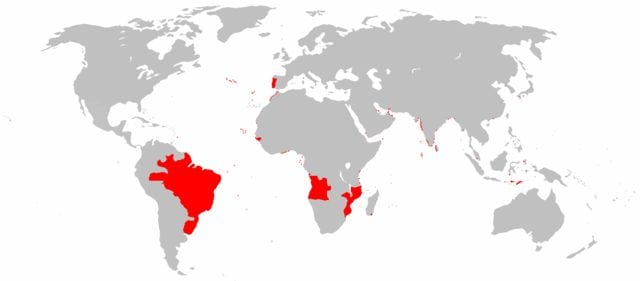
Portuguese empire
Lasting for about six centuries (capture of Ceuta in 1415 – handover of Portuguese Macau to China in 1999)
From the early 16th century a global empire with bases in North and South America, Africa, Asia and Oceania
Along with the Spanish Empire often described as the first global empire in history
Courtesy Wikimedia Commons
Dutch Empire

Dutch empire
French Empire

French empire
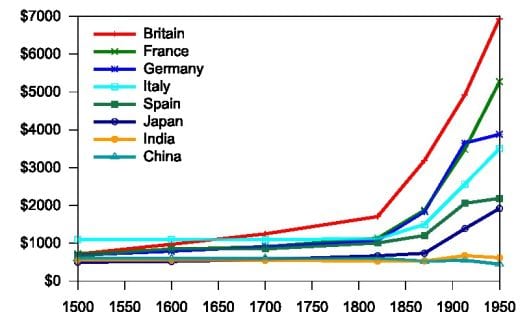
Great divergenceEstimates of GDP per capita at purchasing power parity in 1990 international dollars for selected European and Asian nations between 1500 and 1950,[2] showing the explosive growth of some European nations from the early 19th century.Courtesy Wikimedia Commons
Spanish Empire
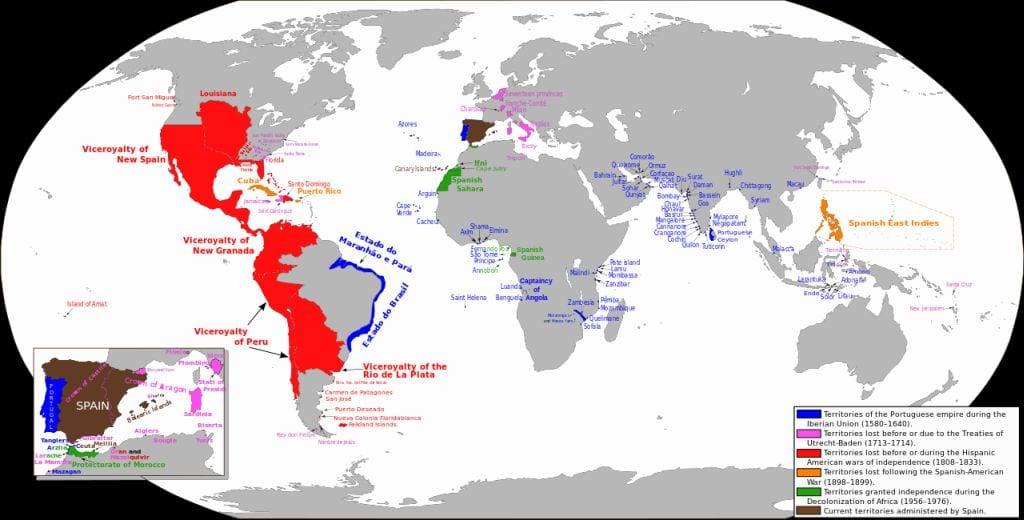
Spanish empireOne of the largest empires in history lasting from the late 15th century to the early 19th with territories in the New World and Philippines (the Spanish ‘Indies’
Also territories in Europe, Africa and Oceania.
With the Portuguese Empire regarded as the first global empire in history
The world’s most powerful empire from the 16th to the first half of the 17th century with its greatest extent occurring in the 18th century.

